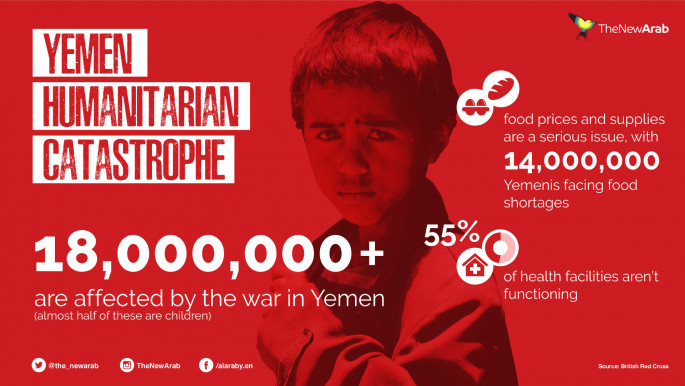
Inside Yemen, six years after the 'Friday of Dignity'
Yemen's dreadful ordeals have not ceased for the past six years.
Events in the capital on March 18, 2011, ushered in uncontrollable turbulence and a truly gloomy era.
It was the Friday of Dignity, in which at least 45 anti-regime peaceful protesters were killed in broad daylight. Hundreds more were injured.
Today, Yemen is commemorating the sixth anniversary of that massacre. Sorrowfully, countless days of carnage have followed that day, and the nation today is upside down. The Friday of Dignity was the first terrible bloodshed of Yemen's Arab Spring uprising.
The uprising hoped to fulfil the dreams of the masses. The search for that dream remains ongoing, and the setbacks have been more than the gains. The people have been fragmented and the conflict is intensifying. When the youths began calling for change, they did so near a university campus in the capital. Today, the fallout of the uprising has reached every corner nationwide.
It is easy to answer the question of when Yemen's first Arab Spring massacre was carried out. The tougher question is to ask when the final massacre will be. When will Yemen stop seeing blood shed for the sake of power and politics?
Mistaken airstrikes have resulted in several massacres. Shelling has also left carnage, while suicide attacks have killed innumerable scores of people. It has been an unspeakable mess, accumulating steadily.
The Friday of Dignity was a harrowing prologue to a painful time for this volatile country. For the revolutionary youths, their blood was spent in a bid to build their desired future of Yemen.
 |
It was almost 1:00pm when Change Square was turned into the site of death, bloodshed, tears, fire and chaos. The columns of smoke rose to darken the sky |  |
The gruesome scene
On March 18, 2011, protesters swarmed to perform the Friday congregation prayer in Sanaa's Change Square. It did not occur to them that their spirituality would be disturbed by brutality.
When the protesters concluded their prayer, they began to march. Peace disappeared and the tumult broke out.
It was almost 1:00pm when Change Square was turned into the site of death, bloodshed, tears, fire and chaos. The columns of smoke rose to darken the sky and the surrounding buildings were hard to see.
A bloody clash flared up between armed men in civilian clothes and unarmed protesters. The only sounds heard were the firings of Kalashnikovs, and the protesters' howls of pain.
The protesters were trying to demolish the concrete wall erected earlier by the anti-protest armed men. Burning tires were ablaze behind the wall, hindering protesters' movement. They pushed beyond the wall and extinguished the flames. But a hail of bullets rained down upon the sea of daring protesters, killing and injuring hundreds.
 |
The protesters were striving to move forward, but the armed men were sending death to any risk-takers. The Yemen uprising saw its first pools of blood on the street. That worrying development drew a strong local and regional reaction to the popular uprising.
Upon seeing and hearing the news, many government officials at the time defected from former president Ali Saleh's regime. That was one significant result of the Friday of Dignity. Defections continued and divisions became more entrenched.
The capital began experiencing a state of turbulence, as did many provinces across the nation.
Rights agencies denounced the attack on peaceful protesters. Human Rights Watch reported "excessive force causing deaths and injuries to largely peaceful protesters".
In March 2011, the country slid from contending with rivalry among political parties to a fundamentally divided people, with a fractured army, fragile security and other numerous challenges.
Bodies buried, troubles alive
Former President Saleh clung to power as mass protests were unstoppable in many cities. The protests, which kicked off in February, 2011, took a long time to pay off. In February 2012, he handed power to Abd Rabbo Mansour Hadi, the vice-president at the time.
 |
Those who appeared at the conference would not have been there without the Friday of Dignity |  |
In 2013, Hadi, the consensus interim president, launched the National Dialogue Conference. The conference began on March 18, in remembrance of and as tribute to the sacrifices of the youths on the Friday of Dignity in 2011.
The conference hosted 565 participants, hailing from across the political spectrum and repesenting backgrounds including the handicapped and the marginalised. Those who appeared at the conference would not have been there without the Friday of Dignity.
The uprising seemingly came to make everyone equal.
The national dialogue commenced to soak up the blood and give justice to those wronged. But as time went by, Yemenis came to know that the Friday of Dignity was only the beginning of a bloody era. The conference drew to a close in early 2014, yet an end to the uncertainty surrounding the country was still beyond reach.
Today, after six years of both peaceful struggle and war, Yemenis have not found their path to peace or justice.
Public memory may not forget the Friday of Dignity. However, the number of tragedies since are too many to count. The country is fed up with atrocities, and there is no end in sight to this violence.
The bodies of the dead of the Friday of Dignity massacre were buried years ago. The corpses may have turned into dust deep within the ground, yet the country is still in the throes of war, penury and mayhem.
Khalid Al-Karimi is a freelance reporter and translator. He is a staff member of the Sanaa-based Yemeni Media Center and previously worked as a full-time editor and reporter for the Yemen Times newspaper.
Follow him on Twitter: @Khalidkarimi205
Opinions expressed in this article remain those of the author and do not necessarily represent those of The New Arab, its editorial board or staff.




